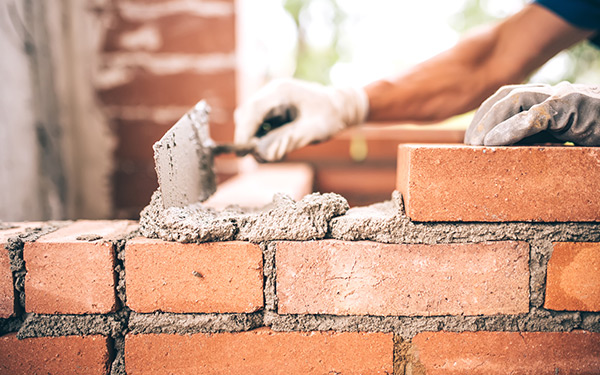Reliable Tuckpointing Services for Fixing Block and Stone Surfaces
Reliable Tuckpointing Services for Fixing Block and Stone Surfaces
Blog Article
Unlocking the Secrets of Lasting Masonry Building Practices for Eco-Friendly Buildings
Amongst the myriad methods to green building, sustainable stonework construction stands out as a reliable and resilient approach that holds a riches of untapped potential. From the choice of products to cutting-edge construction methods, the keys to achieving sustainability within stonework building and construction are complex and interesting.
Benefits of Sustainable Masonry Building And Construction
Welcoming lasting masonry construction techniques not only decreases ecological effect however likewise uses lasting financial advantages to builders and areas. By using materials like recycled blocks, obstructs, and stones, builders can significantly reduce the carbon footprint of their tasks while promoting source efficiency. Additionally, lasting stonework building and construction methods, such as proper insulation and thermal mass properties, can boost energy performance within buildings, causing minimized functional expenses with time.
In addition, the longevity and durability of stonework structures add to long-term economic advantages. Buildings created using lasting stonework methods usually require much less upkeep and repair work, equating to set you back savings for home builders and homeowner. The longevity of masonry products additionally guarantees that frameworks remain stable and safe, reducing the need for regular renovations or replacements.
Eco-Friendly Stonework Materials
Using eco-friendly masonry materials is a critical action in the direction of boosting the sustainability of building techniques and minimizing environmental effect while maximizing long-lasting economic benefits. Sustainable masonry materials are sourced, produced, and utilized in a way that minimizes general ecological influence. Products such as recycled blocks, reclaimed stone, and sustainable concrete blocks are ending up being progressively prominent options for eco-conscious building contractors. Recycled bricks, for example, not only divert waste from garbage dumps yet additionally need much less power to create compared to brand-new blocks. Recovered stone offers an unique aesthetic allure while lowering the demand for new quarrying. Sustainable concrete obstructs include recycled accumulations and might include improved insulation homes, adding to power performance in buildings.
In addition, natural products like adobe, rammed earth, and straw bundles offer superb thermal mass residential properties, decreasing the demand for heating and cooling down energy. These products are frequently in your area available, promoting local economies and lowering transportation-related carbon exhausts. By selecting eco-friendly masonry products, building and construction projects can dramatically reduce their environmental footprint and add to the production of healthier, much more lasting constructed environments.
Energy-Efficient Masonry Methods
Energy performance plays an essential duty in improving the sustainability of stonework building practices. One key energy-efficient stonework technique is the use of thermal mass, which entails incorporating thick materials like concrete or block right into the building's structure to take in and store heat.

Innovations in Lasting Masonry
Current innovations in sustainable stonework techniques have caused innovative methods that are reshaping the building market. One such technology is browse around this site the development of self-healing concrete, which uses microorganisms embedded within the concrete to heal fractures autonomously. This breakthrough not only decreases upkeep costs however likewise boosts the resilience of masonry frameworks, adding to their sustainability.
An additional notable development is using recycled accumulations in stonework construction - masonry contractor. By incorporating materials such as smashed ceramic concrete patio overlay cost waste or recycled glass right into concrete blends, builders can decrease the ecological impact of construction projects while maintaining structural integrity. This method not only diverts waste from garbage dumps but also preserves natural deposits, making it a crucial advancement in lasting masonry construction
In addition, the integration of digital design devices, such as Structure Info Modeling (BIM), is revolutionizing the method masonry structures are planned and created. BIM permits for even more exact computations, decreased material wastage, and boosted power effectiveness, eventually resulting in more lasting building techniques. These innovations jointly symbolize an appealing future for sustainable stonework building and construction in the age of green buildings.
Future Trends in Masonry Sustainability
With the innovative strides made in lasting stonework practices, the future fads in stonework sustainability are poised to further change the building and construction market. One of the vital fads shaping the future of stonework sustainability is the boosted integration of modern technology. Improvements such as Building Details Modeling (BIM) and online reality simulations are being made use of to enhance stonework building processes, bring about decreased material waste and enhanced energy efficiency in structures.
Additionally, the growth of novel lasting materials is readied to play a considerable role in boosting the eco-friendliness of masonry building. masonry contractor. Technologies like self-healing concrete, recycled aggregates, and bio-based binders are obtaining traction for their capability to minimize environmental influence while preserving architectural integrity

Conclusion
To conclude, sustainable masonry building techniques supply countless advantages for eco-friendly buildings. By making use of eco-friendly products and energy-efficient strategies, stonework can add to a much more sustainable built environment. Innovations in sustainable masonry are constantly being established to even more enhance the environmental efficiency of structures. Looking in the direction of the future, the pattern of masonry sustainability is expected to grow, resulting in even more eco-friendly and energy-efficient building and construction practices in the years to come.
Report this page